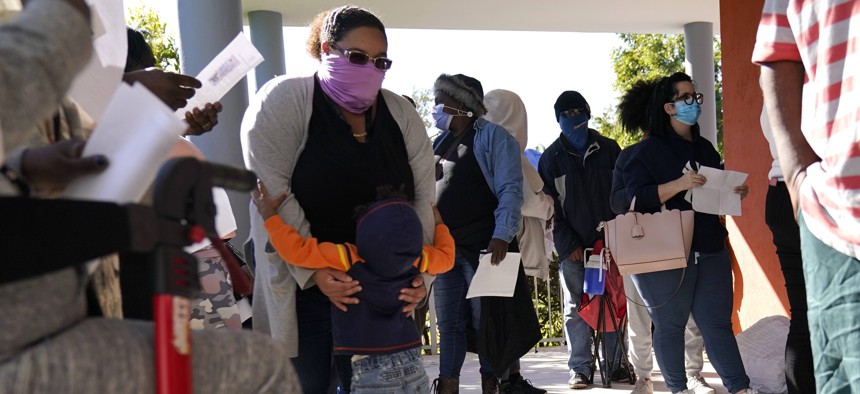Pandemic Relief Aid Highlights Gaps Reaching Underserved Americans

People wait in line to receive a $250 grocery gift card available to Miami residents experiencing hardship and food insecurity due to COVID-19, Tuesday, Dec. 8, 2020, in Miami. The CARES Act provides the funding for the cards. AP Photo/Lynne Sladky
Lessons learned so far could inform how states and localities design new programs funded with an influx of federal dollars.
The federal government over the past year and a half has pumped upwards of $5 trillion toward pandemic relief programs, spending that is widely credited with preventing the coronavirus from delivering an even worse blow than it dealt to the nation’s economy.
But experts point to ways that programs designed to help struggling households and businesses fell short reaching underserved groups and racial and ethnic minorities. Some of this feedback and criticism may prove useful for state and local policymakers to consider as they roll out programs funded with the billions in federal aid their jurisdictions are receiving.
“We’ve been able to get a lot of money out really quickly,” Shena Ashley, vice president of nonprofits and philanthropy at the Urban Institute said during an online event this past week.
“But there have been some challenges, particularly around uptake, mostly because we have relied on systems and networks and experiences that existed before the pandemic that were not necessarily built with an equity infrastructure in mind,” she added.
Ashley spoke during a roundtable hosted by the National Academy of Public Administration and the federal Pandemic Response Accountability Committee.
She noted, for example, that some aid programs depend on individuals and businesses having relationships with banks, bank accounts or stable addresses, which while common for many Americans, are not a given among poorer and underserved groups.
Andre Perry, a senior fellow with the Metropolitan Policy Program at the Brookings Institution, raised similar concerns. “Who do we center when we are creating these policies?” he said.
Perry highlighted the Paycheck Protection Program, which provided hundreds of millions of dollars to businesses to help cover payroll and other costs during the depths of the pandemic. He noted that businesses worked through banks to access these funds, but that Black business owners tend to have weaker ties to banks compared to their white peers.
“We could have started with the Black entrepreneur in mind, yet we didn’t,” he said.
Another complication Perry flagged is how to take wealth into account when designing and implementing programs. People who lack wealth, he explained, are less equipped to lean on savings or equity in property during times of financial stress, leaving these individuals more likely to resort to higher cost borrowing options like credit cards.
Perry also said he thinks the way some of the pandemic assistance programs have played out illustrates the need for a public banking system of some sort, that would allow for the government to distribute aid directly to people when unforeseen events like the pandemic strike.
“To make sure we can get funds to individuals faster,” he said.
‘Broader Imagination’ Needed
Clarence Wardell III, chief data and equitable delivery officer with the White House’s American Rescue Plan Act implementation team, distinguished between two types of programs. There are those designed to deliver benefits automatically—like the federal stimulus payments many individuals received, or child tax credits. And there are others where people need to sign up.
But—similar to what the others who spoke at the event were getting at—he reflected on how the more automatic programs tend to rely on existing systems that people who are traditionally underserved might fall outside of.
“Where we’re spending a lot of our time is … awareness and outreach and supporting folks, hands on with enrollment,” he said, adding that it can be difficult for people to keep up with all of the assistance programs launched since last year and how to access them.
Ashley said that with emergency dollars, more funding has generally been unlocked when programs have greater flexibility. For instance, allowing people to verify income using digital, rather than original, copies of documents. Or, when the Treasury Department tweaked language to allow for assistance to those indirectly, as opposed to just directly, harmed by Covid-19.
“This new landscape has to be matched with a broader imagination in the way that we deliver the programs and not adding more administrative burden, or issues on top of people to prevent them from accessing the particular benefits,” Ashley added.
Bill Lucia is a senior editor for Route Fifty and is based in Olympia, Washington.
NEXT STORY: What Works? Evidence and Evaluation Key as States and Localities Spend Aid






